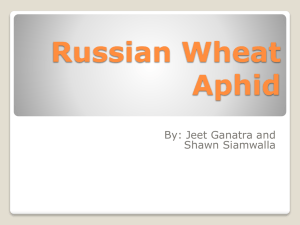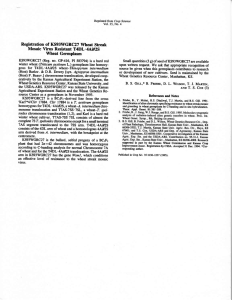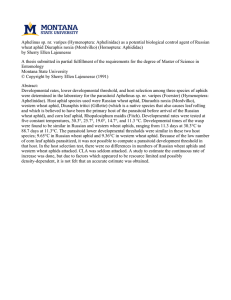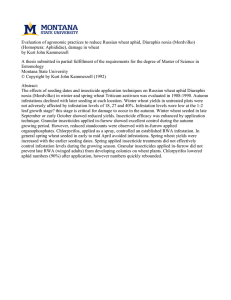AES Field Evaluations of Selected Insecticides to Control Russian Wheat Aphid
advertisement
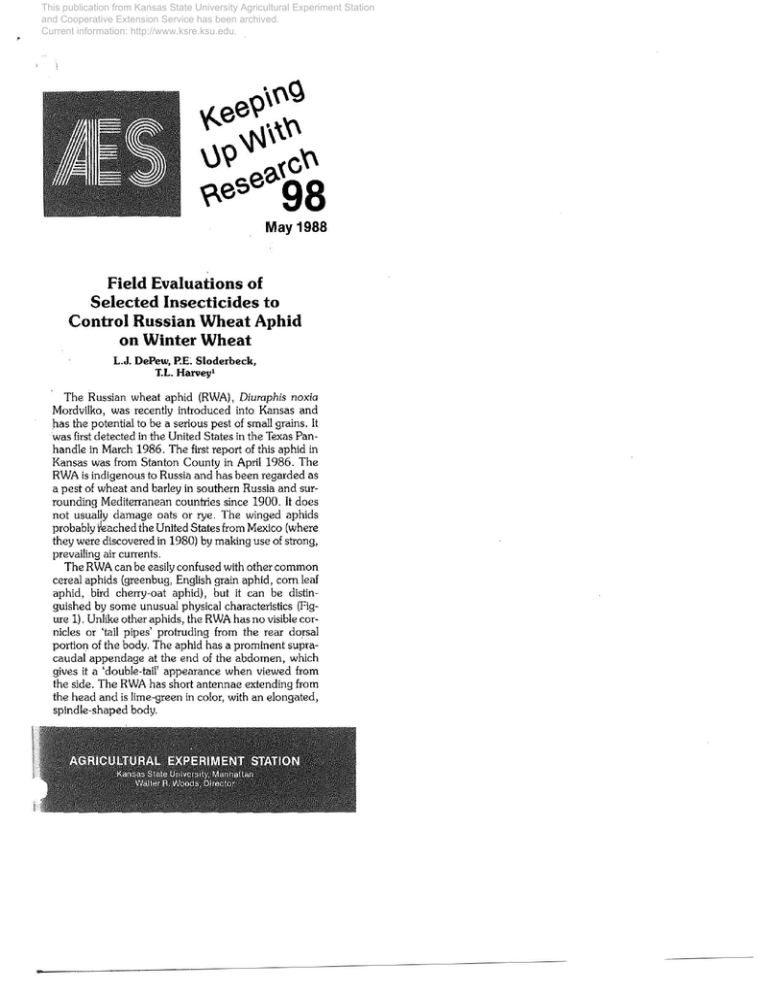
This publication from Kansas State University Agricultural Experiment Station
and Cooperative Extension Service has been archived.
Current information: http://www.ksre.ksu.edu.
AES
May 1988
Field Evaluations of
Selected Insecticides to
Control Russian Wheat Aphid
on Winter Wheat
L.J. DePew, P.E: Sloderbeck,
T.L. Harvey1
The Russian wheat aphid (RWA), Diuraphis noxia
Mordvilko, was recently introduced into Kansas and
has the potential to be a serious pest of small grains. It
was first detected in the United States in the Texas Panhandle in March 1986. The first report of this aphid in
Kansas was from Stanton County in April 1986. The
RWA is indigenous to Russia and has been regarded as
a pest of wheat and barley in southern Russia and surrounding Mediterranean countries since 1900. It does
not usually damage oats or rye. The winged aphids
probably ~ached the United States from Mexico (where
they were discovered in 1980) by making use of strong,
prevailing air currents.
The RWA can be easily confused with other common
cereal aphids (greenbug, English grain aphid, corn leaf
aphid, bird cherry-oat aphid), but it can be distinguished by some unusual physical characteristics (Figure 1). Unlike other aphids, the RWA has no visible cornicles or 'tail pipes' protruding from the rear do!sal
portion of the body. The aphid has a prominent supracaudal appendage at the end of the abdomen, which
gives it a 'double-tail' appearance when viewed frQm
the side. The RWA has short antennae extending from
the head and is lime-green in color, with an elongated,
spindle-shaped body.
This publication from Kansas State University Agricultural Experiment Station
and Cooperative Extension Service has been archived.
Current information: http://www.ksre.ksu.edu.
Figure 1. Russian wheat aphid, Dluraphis noxia.
Experience in controlling this pest with chemicals is
still very limited in the United States. Information
gleaned from the literature suggests that the RWA may
be difficult to control because it is protected within the
leaf sheaths and tightly rolled leaves of plants. In order
to obtain more information on the effectiveness of insecticidal treatments, field tests were conducted in Kansas during 1987.
Procedure
Field-plot tests were conducted at two locations to
determine the efficacy of selected insecticides against
the RWA, using a randomized complete block design
with three replications.
Sharon Springs (Wallace Co.) Test. Six insecticide treatments {Table 1} were evaluated for RWA control in a farmer-owned field of dryland wheat. Experimental plots measured 18ft X 25ft. A single broadcast
application of each insecticide was made on May 8 using a COz-pressurized, backpack sprayer calibrated to
deliver 12.8 gal/acre through four hollow-cone 6X
nozzles, mounted on a hand-held boom, at 20 psi. The
crop was in Feekes growth stage 10 (boot) at time of application. Population densities of the RWA were assessed prior to treatment and at 4-, 10-, and 21-days
This publication from Kansas State University Agricultural Experiment Station
and Cooperative Extension Service has been archived.
Current information: http://www.ksre.ksu.edu.
Table 1. Efficacy of selected insecticides for control of Ru!;sian wheat aphid on winter wheat. Sharon Springs, Wallace
Co., KS, 1987.
Treatment
Di-Syston 8E
Cygon 400
Parathion 8E
Lorsban4P
Di-Syston 8E +
Parathion 8E
Malathion 57E
Untreated check
Rate
lb (AI) I acre
0.50
0.33
0 .50
0.50
0.42 +
0.25
0.94
0.00
Mean number of RWA per stem• and % control
Pretreat
Day 10
Day 4
Day21
70.1
88.8
93.7
102.3
3.9a (94)
5.6a (94)
6.0a (94)
6.4a (94)
1.6a (97)
3.2a (96)
6.9a (92)
3.0a (97)
128.5
134.3
77.6
6.4a (95)
13.0a (90)
77.1b (- )
3.3a (97)
19.2b (84)
67.3c (-)
Wheat
yield
bu/acre
(66)
(88)
(66)
(94)
8 .04
10 .60
8.70
8.07
16.0ab (84)
34.0bc (68)
61.3d (-)
6.48
6 .90
4.35
N.S.
18.8abc
8.0ab
25.0bc
4.7a
•Means in same column followed by same letter are not significantly different {P = 0.05) , DMRT. Percent control shown in parentheses.
bNot currently labeled for use on wheat.
posttreatment. Ten culms per plot were collected and
placed into Berlese funnels for a period of 48 hours to
extract the aphids into recovery jars containing 70% alcohol. Samples were then filtered through Buchner
funnels to separate the aphids from the alcohol. Aphids
. , were counted utilizing a binocular microscope. Grain
(.. )yield estimates were obtained on June 18 by handharvesting 32 row-ft from each plot (8 ft from each of
four rows). Samples were threshed, cleaned, and
weighed for yield comparisons.
Hays (Ellis Co.) Test. Eight insecticide treatments
(Table 2) were evaluated for RWA control in a field of
dryland wheat at the Fort Hays Branch Experiment Station. Experimental plots measured 15 ft x 30 ft. Plots
were artificially infested with RWA by taping two infested wheat culms (placed in vials of water) per plot to
the plants so that infested flag leaves were at the same
height as those of the planted wheat. A single broadcast
application of each insecticide was made on May 12 using a self-propelled, high-clearance, ground sprayer
that delivered 20 gal/acre. Treatments were assessed
for initial mortality 1 day after application by removing
the infested culms and counting the number of live
RWA. Residual effectiveness was determined by caging
30 RWA on the flap leaf of each of two randomly selected, treated plants per plot at 7 and 21 days posttreatment. The number of surviving aphids in the cages
was recorded 1 day after each posttreatment date.
Results and Discussion
Sharon Springs (Wallace Co.) Test. All insecticide treatments, when compared to the untreated
(
.
'·
check, significantly reduced RWA 4 days after application (Table 1). The Di-Syston treatment had the fewest
RWAs, but it did not differ significantly from the other
insecticides. Ten days after application, all treated plots
continued to have significantly fewer RWAs than the
untreated check. Except for malathion, there were no
significant differences between insecticides. At 21 days
posttreatment, all treated plots still had significantly
fewer RWAs than the untreated check. Lorsban was the
most effective insecticide at that time and was significantly better than either parathion or malathion.
Grain yields did not differ statistically, but all treated
plots yielded more grain than the untreated check (Table 1). The late application of insecticides, extremely
high RWA densities at the time of application, and plot
variation were probably responsible for the low yields
and nonsignificant data.
Hays (Ellis Co.) Test. All insecticide treatments significantly reduced the number of RWAs, when compared to the untreated check, at 1 day posttreatment
(Table 2). Except for Capture, there were no significant
differences between insecticides. Seven days after application, Di-Syston, Lorsban, Karate, and Capture
provided significant residual control. The other insecticides did not differ significantly from the untreated
check. Karate and Capture gave 100% residual control
at 21 days posttreatment, but they did not differ significantly from Di-Syston, which gave 89% control. Except for Furadan, there were no significant population
differences among treatments compared with the untreated check.
This publication from Kansas State University Agricultural Experiment Station
and Cooperative Extension Service has been archived.
Current information: http://www.ksre.ksu.edu.
Table 2 . Efficacy· of selected insecticides for control of Russian wheat aphid on winter
wheat. Hays, Ellis Co., KS, 1987.
Treatment
Di-Syston 8E
Cygon400
Furadan 4fd
Lorsban 4E•
Parathion 8E
Malathion 57E
Karate 1E•
Capture 2E•
Untreated check
Rate
lb (AI)I acre
0.50
0.33
0.50
0.50
0.75
1.00
0.02
0.04
0.00
Pretreat
Mean number RWA per leaf and % control•
Day 21d
Day 1b
Day 7•
2a (97}
4a (91)
Sa (90)
Sa (89)
8a (84)
9a (82)
9a (81)
20b (58)
47c(-)
6a (72)
20b ( 3)
12ab (42)
4a (81)
18b (17)
22b ( 0)
4a (83)
3a (88)
21b (-)
2a ( 89)
13c ( 17)
8b ( 49)
15c ( 3)
16c ( 0)
14c ( 14)
Oa (100)
Oa (100)
16c (-)
•Means in same column followed by same letter are not significantly different (P = 0.05), DMRT. Percent control shown in parentheses.
bMean number of aphids from artificially Infested leaves.
•Mean number of aphids 1 day after caging aphids on flag leaves.
dNot currently labeled for aphid control on wheat.
•Not currently labeled for use on wheat.
Conclusions
Results of these trials indicate that among the insecticides broadly labeled for aphids on small grains, DiSyston, Cygon, and parathion gave excellent initial
control of RWA, but residual effectiveness varied.
Among the insecticides not currently labeled for application to wheat, Lorsban, Karate, and Capture gave excellent initial control and good residual activity at the
·
rates tested.
Producers are urged to consult with their local county
agricultural extension agent and/ or the current issue of
the Kansas 'Wheat Insect Management Guide' for assistance in selecting the right insecticide (s) for RWA
control on winter wheat.
Brand names are used to identify products. No endorsement
is intended, nor is any criticism implied of similar products not
mentioned. l.orsban, Karate, and Capture insecticides
do not have current label registration for use on wheat
and CANNOT be utilized for that purpose until they re·
ceive proper labeling. Furadan is not currently labeled
specifically for aphid control on wheat and, therefore, _
CANNOT be used for RWA control on that crop unless
future labe l changes are made.
'Research Entomologist, Dept. of Entomology and
SW Kansas Branch Experiment Station, Garden City;
Extension Entomologist, SW Area Extension Office,
Garden City; and Research Entomologist, Dept. of
Entomology and Fort Hays Branch Experiment Station, Hays, respectively.
Contribution No. 88-41 3-S from the KAES
Agricultural Experiment Station, Manhattan 66506
Keeping Up With Research 98
May 1988
Publications and public meetings by the Kansas
Agricultu raJ Experiment Station are available and
open to the public regardless of race, color, national origin, sex, or handicap.
5-88- 3M
